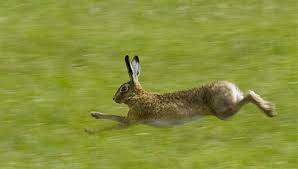Hare (Lepus europaeus) have a length of 60 to 70 cm, a height of 25 to 30 cm and weigh between 4 and 5 kg. They have very long legs and ears (7.9 to 14 cm). The hind legs are longer (15 cm) and more powerful than the front legs. Each paw has five toes and hairy pads. The hind legs count only four toes.
 His ears can move independently of each other and rotate up to 190°.
His ears can move independently of each other and rotate up to 190°.
Their sense of smell is like hearing well developed.
The hare shed his fur twice a year, in spring and in autumn. The summer coat is lighter in color than the more reddish winter coat.
Hares appear to endure badly rain.
On average, they can become (in the wild) 3 years old.
Hares eat grasses and herbs. In winter he also eats bark, mushrooms, acorns, nuts and berries. The hare drinks rarely, and takes most of the moisture from its food.
The stomach is relatively very large. This allows him overnight to the uptake of a large supply of food, and he can keep low profile during the day.
Like rabbits also hares produce stomach pills. Caecotrophy means that they immediately eat it again like spinach balls.
If the hare discovers an enemy he pressed himself flat against the ground, trusting his camouflage. If the robber gets too close, he will suddenly hard sprint away. He flees with zigzag strokes or hooks: 90° angles on his run direction. He can make leaps of 3.7 meters long and 1.5 meters high.
The main predator is the red fox whose diet can consist for up to 46% of hares.
The hare has a number of forms, resting places on the ground with vegetation as windbreaks where he holds a (short and very light) catnap.
The doe has a super uterus. If she is pregnant, she can still be fruitful and re- covered. They may therefore have fetuses of different ages in there womb.
The average gestation period is 42 days. A mature, healthy doe raises an average of eleven to thirteen young per year in three to four litters. New hares can be born again 12 days after a previous.
The little’s are nidifugous and born with open eyes and completely hairy and are instantly able to walk.
From the roost to the feeding areas they use fixed paths and tracks.
If you catch them or shoot, first press the bladder empty (from chest to anus) before you take them.
Hare was with the Romans much more popular than rabbit. They were grown on plots that were demarcated with fences deep in the ground.
